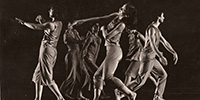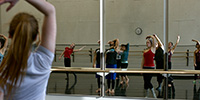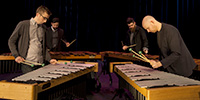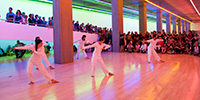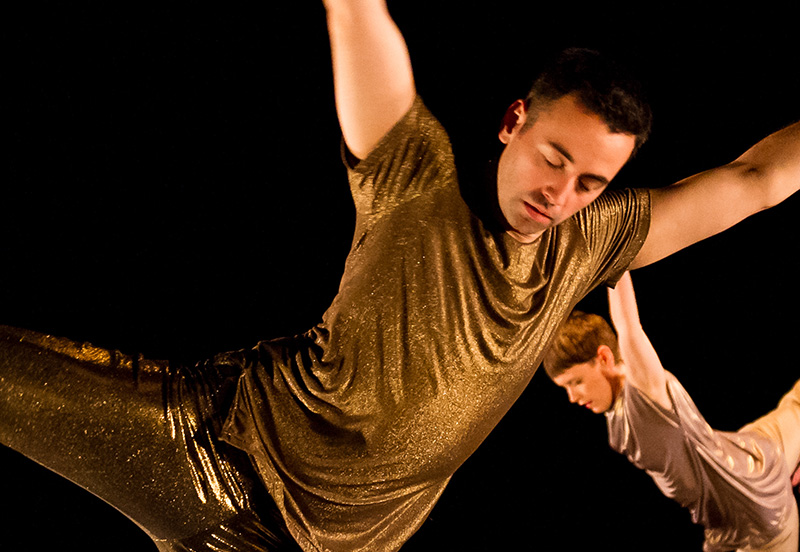You are here
Trisha Brown Dance Company
Feb 04 — Feb 06Performance Dates
- Thu Feb 04 2016 8:00 PM
- Fri Feb 05 2016 8:00 PM
- Sat Feb 06 2016 8:00 PM
Venue
A maverick and pioneer of postmodern dance, Washington State native Trisha Brown has spent a lifetime exploring movement that finds the extraordinary in the everyday and challenges existing perceptions of performance. She has pushed the limits of choreography and changed modern dance forever. At 79, Brown has choreographed her last dances. Her company returns to Meany Hall for a retrospective and their final performances of Brown's works for the proscenium stage. “Invariably sensuous, characterized by inventive wit...she keeps adding to the sum of human happiness” (The New York Times). Program to include PRESENT TENSE (2003), Son of Gone Fishin’ (1981), Rogues (2011) and You can see us (1995).
NOTES
CAST
Trisha Brown (Founding Artistic Director and Choreographer) was born and raised in Aberdeen, Washington. She graduated from Mills College in Oakland, California in 1958; studied with Anna Halprin; and taught at Reed College in Portland, Oregon before moving to New York City in 1961. Instantly immersed in what was to become the post-modern phenomena of Judson Dance Theater, her movement investigations found the extraordinary in the everyday and challenged existing perceptions of performance. Brown, along with like-minded artists, pushed the limits of choreography and changed modern dance forever.
In 1970, Brown formed her Company and explored the terrain of her adoptive SoHo making Man Walking Down the Side of a Building (1970), and Roof Piece (1971). Her first work for the proscenium stage, Glacial Decoy (1979), was also the first of many collaborations with Robert Rauschenberg. Opal Loop/Cloud Installation #72503 (1980), created with fog designer Fujiko Nakaya, was followed by Son of Gone Fishin’(1981), which featured sets by Donald Judd. The now iconic Set and Reset (1983), with original music by Laurie Anderson and visual design by Robert Rauschenberg, completed Brown’s first fully developed cycle of work, Unstable Molecular Structure. This cycle epitomized the fluid yet unpredictably geometric style that remains a hallmark of her work. Brown then began her relentlessly athletic Valiant Series, best exemplified by the powerful Newark (1987) and Astral Convertible (1989) – pushing her dancers to their physical limits and exploring gender-specific movement. Next came the elegant and mysterious Back to Zero cycle in which Brown pulled back from external virtuosity to investigate unconscious movement. This cycle includes Foray Forêt (1990) and For M.G.: The Movie (1991). Brown collaborated for the final time with Rauschenberg to create If you couldn’t see me (1994), in which she danced entirely with her back to the audience.
Brown turned her attention to classical music and opera production, initiating what is known as her Music cycle. Choreographed to J.S. Bach’s monumental Musical Offering, M.O. (1995) was hailed as a “masterpiece” by Anna Kisselgoff of the New York Times. Brown continued to work with new collaborators, including visual artist Terry Winters and composer Dave Douglas, with whom she created El Trilogy (2000). She then worked with long-time friend and artist, Elizabeth Murray to create PRESENT TENSE (2003) set to music by John Cage.
Brown stepped into the world of opera to choreograph Carmen (1986) and again to direct Claudio Monteverdi's L’Orfeo (1998). Since then, Brown has gone on to direct four more operas, including, Luci Mie Traditrici (2001), Winterreise (2002) and Da Gelo a Gelo (2006) and most recently, Pygmalion (2010).
Continuing to venture into new terrain, Brown created O Zlozony/O composite (2004) for three étoiles of the Paris Opera Ballet, working with long-time collaborators Laurie Anderson and Jennifer Tipton. Forays into new technology created the witty and sophisticated I love my robots (2007), with Japanese artist and robotics designer Kenjiro Okazaki. Her work with Pygmalion produced two dance pieces L’Amour au théâtre (2009) and Les Yeux et l'âme (2011). Brown’s last work, I’m going to toss my arms- if you catch them they’re yours (2011), is a collaboration with visual artist Burt Barr, whose striking set is dominated by industrial fans. The original music is by Alvin Curran.
As well as being a prolific choreographer, Brown is an accomplished visual artist, as experienced in It’s a Draw (2002). Her drawings have been seen in exhibitions, galleries and museums throughout the world including the Venice Biennale, The Drawing Center in Philadelphia, The New Museum, White Cube, Documenta XII, Walker Art Center, Centre Georges Pompidou, Mills College, Musée d'art Contemporain de Lyon and Museum of Modern Art. Brown is represented by Sikkema Jenkins & Co. in NYC.
Trisha Brown has created over 100 dance works since 1961, and was the first woman choreographer to receive the coveted MacArthur Foundation Fellowship “Genius Award.” She has been awarded many other honors including five fellowships from the National Endowment for the Arts, two John Simon Guggenheim Fellowships, Brandeis University’s Creative Arts Medal in Dance, and she has been named a Veuve Clicquot Grande Dame. In 1988, Brown was named Chevalier de l’Ordre des Arts et des Lettres by the government of France. In January 2000, she was promoted to Officier and in 2004, she was again elevated, this time to the level of Commandeur. She was a 1994 recipient of the Samuel H. Scripps American Dance Festival Award and, at the invitation of President Bill Clinton, served on the National Council on the Arts from 1994 to 1997. In 1999, Brown received the New York State Governor’s Arts Award and, in 2003, was honored with the National Medal of Arts. She had the prestigious honor to serve as a Rolex Arts Initiative Mentor for 2010-11 as well as receiving the S.L.A.M. Action Maverick Award presented by Elizabeth Streb, and the Capezio Ballet Makers Dance Foundation Award in 2010. She has received numerous honorary doctorates, is an Honorary Member of the American Academy of Arts and Letters, and was awarded the 2011 New York Dance and Performance ‘Bessie’ Lifetime Achievement Award. In 2011, Brown was honored with the prestigious Dorothy and Lillian Gish Prize for making an “outstanding contribution to the beauty of the world and to mankind’s enjoyment and understanding of life.” In 2012, Brown became a United States Artists Simon Fellow and received the first Robert Rauschenberg Award from the Foundation of Contemporary Arts. She was honored with the BOMB Magazine Award in 2013, and the Honors Award given by Dance/USA in 2015.
Trisha Brown Dance Company (TBDC) is a post-modern dance company dedicated to the performance, and preservation of the work of Founding Artistic Director and Choreographer, Trisha Brown. Founded in 1970, TBDC has toured throughout the world presenting the work, teaching and building relationships with audiences and artists alike.
Brown engaged collaborators who are themselves leaders in music, theater, and the visual arts, including visual artists Robert Rauschenberg, Donald Judd and Elizabeth Murray, and musicians Laurie Anderson, John Cage and Alvin Curran, to name a few. With these partners, Brown has created an exceptionally varied body of work, with premieres and performances for NYC audiences and international counterparts.
When Brown retired as head of her Company in 2013, the Board appointed longtime Company members Diane Madden and Carolyn Lucas as Associate Artistic Directors with the mandate that they present her dances in a variety of spaces, indoors and out, proscenium and alternative; develop, deepen and expand the Company’s educational initiatives; and treat the Company’s archive as a living organism to be used to better understand her work, in particular, and dance in general.
The Company is currently in its last year of its three-year Proscenium Works, 1979-2011 tour, which has toured to over 50 major national and international locations, with performances throughout Australia, Belgium, Brazil, Canada, China, France, Germany, Greece, Italy, Israel, Portugal, Spain, Slovenia, Switzerland, Turkey, the United Kingdom and within the United States to California, Michigan, North Carolina, Pennsylvania, Rhode Island, Tennessee, South Carolina, Virginia and Wisconsin, Washington as well as New York.
In addition, TBDC has devised a new way to experience Brown’s vast repertory by placing it into unconventional sites. Trisha Brown: In Plain Site is currently touring alongside the Proscenium Works, 1979-2011 tour, and will continue to tour nationally and internationally in 2016 and beyond. Working closely with the presenter, the Company creates a specific program for the venues or sites they select, adapting Brown’s broad range of works into a site-specific performance experience. Special focus is put on the audience engagement at each venue, breaking down access barriers, and providing a more intimate experience to an audience that includes families and people less familiar with modern dance.
The Company’s Education and Outreach program includes worldwide workshops, master classes and lecture demonstrations. Licenses of selected works are given to selected educational institutions and professional companies worldwide, and works are regularly restaged on dance students and professional companies. Recent education and restaging projects include Lyon Opera Ballet, Stephen Petronio Company, Paris Opera Ballet, Candoco Dance Company (London), Belgium’s professional training program P.A.R.T.S., London Contemporary Dance School, Mills College, The Live Legacy Project (Dusseldorf), University of Wisconsin-Milwaukee, Rutgers University, Yale University, Theatre Academy Helsinki (Finland) ,Centre National de Danse Contemporaine Angers (France), and multiple New York institutions including Barnard College, New York University and The New School. TBDC is Founding Partner of Gibney Dance Center’s downtown location in New York City.
Beginning in fall 2015, TBDC is partnering with Bard College in the creation of a comprehensive two-year residency. Drawing inspiration from Brown’s interdisciplinary and collaborative process, TBDC will cultivate a curriculum for students that embody these ideologies through courses in dance technique, repertory and creative practice across forms. In addition, TBDC will have an annual full-company residency, allowing for more in-depth engagement initiatives on campus at the Fisher Center for the Performing Arts.
In 2009, TBDC created the Trisha Brown Archive, working with Archive consultants and long-term staff members on cataloguing the ephemera that surround Brown’s master works, and the preservation of materials that are indispensable to the Company’s working process. TBDC holds significant archival material, including master performance footage of over 90 original works as well as “building tapes” – videos made while Brown created these works. With the generous funds from The Andrew W. Mellon Foundation, TBDC has built a content-rich database for the Trisha Brown Archive, which holds close to 3,000 items from over 40 years of Brown’s artistic work. The Archive further consists of sets, costumes, press, photos, Company records and scores by some of the pre-eminent artists of the era. Archival material is used during the Company’s rehearsal processes and integrated into TBDC’s performance engagements to create a historical context for the work that is seen on stage, and displayed in stand-alone exhibitions worldwide.
RELATED
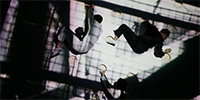
Trisha Brown's Choreography as Visual Art: a Lecture by Susan RosenbergFriday, January 22, 7pmHenry Art Gallery
Susan Rosenberg’s lecture, “Trisha Brown: Choreography as Visual Art,” examines the formative first decade of Brown’s career, to illuminate artistic principles that grounded her work over the next forty years. Considering Brown’s fascination with composer John Cage’s philosophies of indeterminancy and non-intention, as the source of her works’ systematicity, interdiciplinarity and ground-breaking dissolution of boundaries separating dance from visual art, this talk tracks Brown’s deliberately evolutionary artistic trajectory, spanning her first Judson Dance Theater performances to the creation of her first work for the proscenium stage. [ RSVP Link and More Info ]
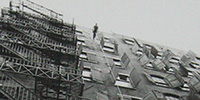
Photo Exhibit
February 1-February 29Meany Hall, Lower Lobby
A collection of twenty-one photographs highlight some of Brown’s most iconic choreographies, spanning fifty years, from 1963-2013, and demonstrate a range of photographic viewpoints and styles by various photographers. The collection was chosen for exhibition at Théâtre de la Ville, Paris in 2013, and is presented in Meany Hall's lower lobby with assistance of the UW School of Art’s Jacob Lawrence Gallery. Open to ticketholders.
Master Class for UW StudentsTuesday, February 2, 12:30-2pm UW Dance Program
Community Master ClassWednesday, February 3, 9:30-11:15amVelocity Dance Center
Velocity Session: A Conversation with TBDC and BANDALOOPWednesday, February 3, 11:30am-1:00pmVelocity Dance Center
This conversation with Associate Artistic Directors of the Trisha Brown Dance Company (Carolyn Lucas and Diane Madden) and BANDALOOP Artistic Director Amelia Rudolph will focus on the creation and performance of site-specific work. Free and open to the public. [ More Info ]
Opening Night Post-show Party with So PercussionThursday, February 4Meany Hall Lobby
Sō Percussion will perform music by John Cage in honor of Trisha Brown. [ More Info ]
BANDALOOP performs Man Walking Down the Side of a BuildingThree performancesFriday, February 5, 10:30am, 11:30am, 12:30pmWest side exterior of Meany Hall (facing 15th Ave NE)
BANDALOOP's Rachael Lincoln, who will perform the piece, is also a lecturer in the UW Dance Program. [ More Info ]
Trisha Brown: In Plain SiteSaturday, February 6, 2pmSeattle Art Museum, South Hall
Trisha Brown: In Plain Site allows Brown’s dances to be freed from the constrictions of the conventional stage and to be once again performed in unexpected locations. But unlike her previous site-specific adventures, Trisha Brown: In Plain Site mines and then recombines material from her vast repertory to accommodate the unique special demands of the particular venue. [ More Info ]
Pre-show DinnerSaturday, February 6, 6pmUW Club
The UW Club hosts a buffet dinner before Trisha Brown Dance Company's performance Saturday evening only. [ More Info ]
Trisha Brown Dance Company on Film: AerosFriday, February 19, 7pmHenry Art Gallery
Join us for a screening of Aeros (1990), a moderated discussion will follow. Working at night, under the glare of automobile headlights, a man scours and restores the facade of a building in New York's SoHo district. With this visual metaphor, director Burt Barr opens Aeros, a look at the evolution of Trisha Brown's dance work Astral Convertible. Choreographed by Brown, with sets and costumes by Robert Rauschenberg, the work premiered in New York in 1989 to critical acclaim. [ RSVP Link and More Info ]

